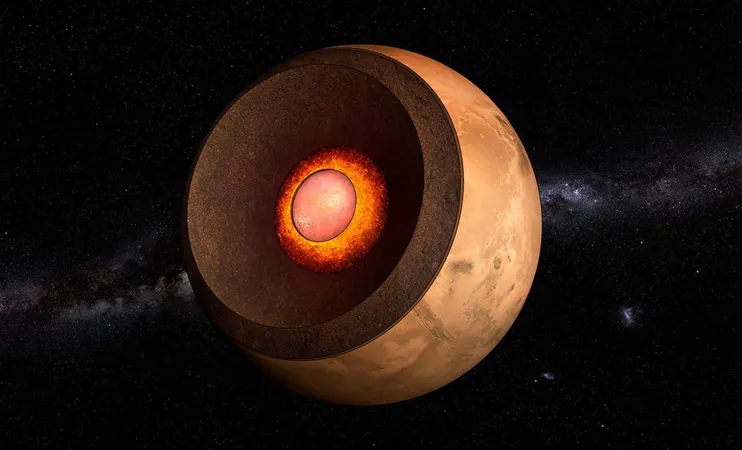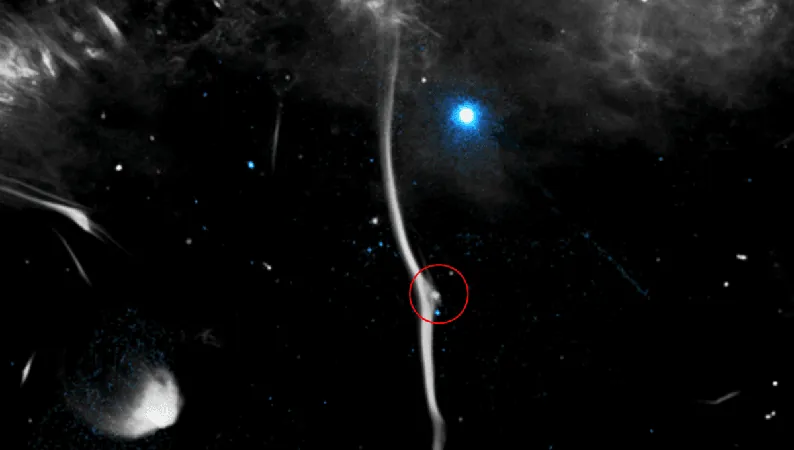
Unlocking Mars' Ancient Secrets: How Its Molten Core Could Explain the Planet's Lost Magnetic Shield
2025-04-24
Author: Wai
Revealing Mars' Magnetic Mysteries
New research from the University of Texas Institute for Geophysics sheds light on the enigmatic nature of Mars' ancient magnetic field. The study proposes a groundbreaking idea: Mars may have once possessed a completely molten core, leading to a magnetic field uniquely concentrated in its southern hemisphere.
A Planet Without a Shield
For decades, scientists have recognized that Mars currently lacks a magnetic field, a factor that has likely contributed to the relentless stripping away of its atmosphere by solar winds. Yet, remarkable findings from the InSight lander suggest that the Red Planet once boasted a protective magnetic shield—essential for sustaining a stable atmosphere and the presence of liquid water.
Mystery of the Skewed Magnetic Field
The discovery of a magnetic field covering only the southern hemisphere has baffled researchers. Why was the northern hemisphere devoid of any detectable magnetic activity? This longstanding puzzle has finally begun to unravel.
The Bold Molten Core Theory
Leading the charge in this revealing study, Chi Yan and his team propose a radical new hypothesis: Mars' core was entirely molten billions of years ago. This phenomenon could have created the perfect conditions for a magnetic field, diverging from the widely accepted notion of a solid inner core enveloped by a molten outer core—similar to Earth.
Temperature Differences and Magnetic Discrepancies
One compelling aspect of this new theory is its focus on thermal gradients between Mars' hemispheres. Researchers speculate that a significant difference in thermal conductivity might explain the uneven magnetic field. Their simulations suggest that the southern hemisphere exhibited higher thermal conductivity, facilitating heat loss and thus birthing a more robust magnetic dynamo there.
Supercomputing Insights Into Mars' Past
To validate their theory, the research team utilized supercomputers at the Maryland Advanced Research Computing Center to simulate the Red Planet’s primordial conditions. By manipulating the molten core's fluid dynamics and varying the crust's conductivity, they discovered that the simulations aligning most closely with data from the InSight and Mars Global Surveyor missions occurred under conditions where Mars' core was fully molten—a stark contrast in heat conductivity between hemispheres.
Mars' Magnetic Legacy and Future Habitability
This captivating research not only provides clues about Mars’ magnetic history but also raises tantalizing questions about the planet's capacity for habitability. Understanding these ancient dynamics could be vital as scientists continue to explore whether Mars could support life, past or present.



 Brasil (PT)
Brasil (PT)
 Canada (EN)
Canada (EN)
 Chile (ES)
Chile (ES)
 Česko (CS)
Česko (CS)
 대한민국 (KO)
대한민국 (KO)
 España (ES)
España (ES)
 France (FR)
France (FR)
 Hong Kong (EN)
Hong Kong (EN)
 Italia (IT)
Italia (IT)
 日本 (JA)
日本 (JA)
 Magyarország (HU)
Magyarország (HU)
 Norge (NO)
Norge (NO)
 Polska (PL)
Polska (PL)
 Schweiz (DE)
Schweiz (DE)
 Singapore (EN)
Singapore (EN)
 Sverige (SV)
Sverige (SV)
 Suomi (FI)
Suomi (FI)
 Türkiye (TR)
Türkiye (TR)
 الإمارات العربية المتحدة (AR)
الإمارات العربية المتحدة (AR)